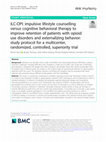Papers by Birgitte Thylstrup
Journal of substance use and addiction treatment, Jun 1, 2024
Drug and Alcohol Dependence, Dec 31, 2023
http://isrctn.com/, Sep 4, 2020
Klinisk sygepleje, May 4, 2016
http://isrctn.com/, Dec 6, 2022

Nordic studies on alcohol and drugs, Oct 1, 2011
BIRGITTE THYLSTRUP Numbers and narratives. Relations between patient satisfaction, retention, out... more BIRGITTE THYLSTRUP Numbers and narratives. Relations between patient satisfaction, retention, outcome and program factors in outpatient substance abuse treatment Research report Acknowledgements Thank you to Morten Hesse for the working relationship on the project and to the participating patients and to the research colleagues Lotte Skot, Angelina Mellentin, Sidsel Schrøder, Liv N. Heerwagen and Simon Gelvad for their involvement in the data collection. The study was part of a quality assurance project ordered by the Danish Ministry of Social Affairs. AbSTRACT AIMS-Research on substance abuse treatment suggests patient satisfaction is linked to use of services and abstinence. However, patient perspectives on treatment are rarely examined. This study used mixed methods to examine correlations between patients' treatment satisfaction, retention and abstinence from drugs and provide a transpersonal account of patient perspectives on treatment. DATA AND METHODS-Eight Danish outpatient substance abuse treatment centres participated in the study. Data was collected from 186 patients. Quantitative measures were used at baseline screenings and at 6 months follow-up interviews, including the Client Satisfaction Questionnaire-8 (CSQ-8). Qualitative measures were used for patient descriptions of treatment at follow-up. RESULTS-Patient satisfaction with treatment was linked to retention, abstinence and program differences. The qualitative data described patient's views on high or low treatment satisfaction. CONCLUSION-The CSQ-8 is a valuable tool for monitoring patient engagement and treatment effect in substance abuse treatment services. The inclusion of patient perspectives underlined the importance of a more contextual understanding of program components.
The International Journal of Alcohol and Drug Research, May 24, 2018
Background: The current level of alcohol consumption has placed Nigeria and Uganda in the group o... more Background: The current level of alcohol consumption has placed Nigeria and Uganda in the group of high consumption countries, however little is known about how people with problematic alcohol use and related problems utilize treatment services. Aims: This study examined the relationship between alcohol consumption and mental health status in Nigeria and Uganda, and the relationship between heavy episodic drinking and treatment-seeking and treatment-receiving behavior.

Harm Reduction Journal, Jul 10, 2021
Background: The use of cannabis as medicine (CaM) both prescribed and non-prescribed has increase... more Background: The use of cannabis as medicine (CaM) both prescribed and non-prescribed has increased markedly in the last decade, mirrored in a global shift in cannabis policy towards a more permissive stance. There is some evidence that cannabis functions as a substitute for prescription drugs, particularly opioids; however, more knowledge is needed on the motives of substitution users, their patterns of use, and perceived effects of substitution use. Aims: To explore who substitutes prescription drugs with cannabis, the type of prescription drugs substituted and the type of cannabis used, and the impact that substitution with cannabis has on prescription drug use as well as the motives for substitution in terms of experienced effects and side effects. Methods: A self-selected convenience sample was recruited through social media, public media, and patient organizations to take part in an anonymous online survey. Inclusion criteria were 18 years or older and use of cannabis (prescribed or non-prescribed) with a medical purpose. Results: The final sample included 2.841 respondents of which the majority (91%) used non-prescribed cannabis, and more than half (54.6%) had used CaM with the purpose of replacing a prescribed drug. Compared to non-substitution users, substitution users were more likely to be women and to use CaM in the treatment of chronic pain and other somatic conditions. Pain medication (67.2%), antidepressants (24.5%), and arthritis medication (20.7%) were the most common types of drugs replaced with CaM. Among substitution users, 38.1% reported termination of prescription drug use, and 45.9% a substantial decrease in prescription drug use. The most frequent type of cannabis used as a substitute was CBD-oil (65.2%), followed by 'hash, pot or skunk' (36.6%). More than half (65.8%) found CaM much more effective compared to prescription drugs, and 85.5% that the side effects associated with prescription drug use were much worse compared to use of CaM. Conclusion: CaM is frequently used as a substitute for prescription drugs, particularly opioids. More research is needed on the long-term consequences of use of CaM, including the impact from low and high THC cannabis products on specific somatic and mental health conditions.

Nordic Studies on Alcohol and Drugs, 2022
Background: The aim of this study was to document employees’ experiences of changes in service pr... more Background: The aim of this study was to document employees’ experiences of changes in service provision for substance use disorders (SUDs) during the first COVID-19 lockdown in Denmark (spring 2020), as well as to examine their relation to challenges in meeting the service users’ needs. Methods: Employees ( N = 373) working in SUD treatment and harm reduction services completed an online survey soon after the first national lockdown. The survey included questions about changes in service provision during the lockdown, perceived concerns of the service users, and challenges in meeting the users’ emerging needs. Results: Employees reported some positive changes in service provisions, such as increased flexibility in appointments, administering medication-assisted treatment (MAT), and use of telehealth. Negative changes were related to reduced contact with practitioners and harm reduction facilities. Approximately one third of employees reported significant challenges in meeting the u...
Nordic Studies on Alcohol and Drugs, 2009

Neuroscience & Biobehavioral Reviews, 2021
Cannabis use peaks during adolescence and emerging adulthood, and cannabis use disorder (CUD) is ... more Cannabis use peaks during adolescence and emerging adulthood, and cannabis use disorder (CUD) is associated with a wide range of adverse outcomes. This is particularly pertinent in youth, because the developing brain may be more vulnerable to adverse effects of frequent cannabis use. Combining evidence-based psychosocial interventions with safe and effective pharmacotherapy is a potential avenue to improve youth outcomes, but we lack approved CUD pharmacotherapies. Here, we review new potential avenues for helping youth with CUD, with a particular focus on cannabinoid-based treatments. Evidence from placebo-controlled RCTs suggests synthetic delta-9-tetrahydrocannabinol (THC) decreases withdrawal symptoms, but not cannabis use, in adults with daily cannabis use/CUD, while findings regarding formulations containing THC combined with cannabidiol (CBD) are mixed. Preliminary evidence from two placebo-controlled RCTs in adults with CUD suggests that both Fatty Acid Amide Hydrolase inhibitors and CBD can reduce cannabis use. However, larger trials are needed to strengthen the evidence. Findings from adults point to cannabinoid-based treatments as a potential strategy that should be examined in youth with CUD.
Aarhus University Press eBooks, Jun 21, 2016
Aarhus University Press eBooks, Jun 14, 2017

Nordic studies on alcohol and drugs, Feb 25, 2021
Background:In Denmark the boundaries between cannabis as an illicit drug and licit medicine have ... more Background:In Denmark the boundaries between cannabis as an illicit drug and licit medicine have shifted rapidly in recent years, affecting also policy. However, the vast majority of Danes, who use cannabis as medicine (CaM) continue to rely on the unregulated market for supply. This study explores patterns of use and motives for use of CaM in Denmark.Methods:An anonymous online survey was made available to a convenience sample of users of CaM from July 14, 2018 to November 1, 2018. Participants were recruited through patient organisations, social and public media, and the illegal open cannabis market.Results:Of the final sample (n = 3,021), a majority were women (62.6%) and the mean age was 49 years. Most had no prescription for CaM (90.9%), a majority had no or limited previous experience with recreational cannabis use (63.9%), and had used CaM for two years or less (65.0%). The most common form of intake was oil (56.8%) followed by smoke (24.0%). CBD oil (65.0%) was used more than hash, pot or skunk (36.2%). Most frequent conditions treated were chronic pain (32.0%), sleep disturbances (27.5%), stress (23.7%), osteoarthritis (22.7%), anxiety (19.6%), and depression (19.6%). Overall, users experienced CaM to be effective in managing somatic and mental health conditions and reported relatively few side-effects. CBD oil only users were more likely to be women, older, have limited recreational experience and have initiated use recently.Conclusions:A new user group has emerged in Denmark that, for the most part, use illegally sourced CaM to treat a broad range of somatic and mental health conditions, often with experienced effect and relatively low level of side-effects. The prevalent use of low-potency CBD oil indicates an interest in effects beyond the high normally associated with cannabis use. More clinical research into the effects and side-effects of CaM is needed to draw the boundaries of the medical utility of cannabis.

BMC Psychiatry, Apr 7, 2021
Background: Substance use disorders show a high comorbidity with externalizing behavior difficult... more Background: Substance use disorders show a high comorbidity with externalizing behavior difficulties, creating treatment challenges, including difficulties with compliance, a high risk of conflict, and a high rate of offending post-treatment. Compared with people with other substance use disorders those with opioid use disorders have the highest risk of criminal activity, but studies on the evidence base for psychosocial treatment in opioid agonist treatment (OAT) are scarce. The Impulsive Lifestyle Counselling (ILC) program may be associated with better retention and outcomes among difficult-to-treat patients with this comorbidity. Methods: The study is a multicenter, randomized, controlled, superiority clinical trial. Participants will be a total of 137 hard-to-treat individuals enrolled in opioid agonist treatment (OAT). Participants will be randomized to either a standard treatment (14 sessions of individual manual-based cognitive behavioral therapy and motivational interviewing (MOVE-I)) or six sessions of ILC followed by nine sessions of MOVE-I. All participants will receive personalized text reminders prior to each session and vouchers for attendance, as well as medication as needed. The primary outcome is retention in treatment. Secondary measures include severity of drug use and days of criminal offending for profit three and nine months post-randomization. A secondary aim is, through a case-control study, to investigate whether participants in the trial differ from patients receiving treatment as usual in municipalities where ILC and MOVE-I have not been implemented in OAT. This will be done by comparing number of offences leading to conviction 12 months post-randomization recorded in the national criminal justice register and number of emergency room contacts 12 months post-randomization recorded in the national hospital register.











Uploads
Papers by Birgitte Thylstrup